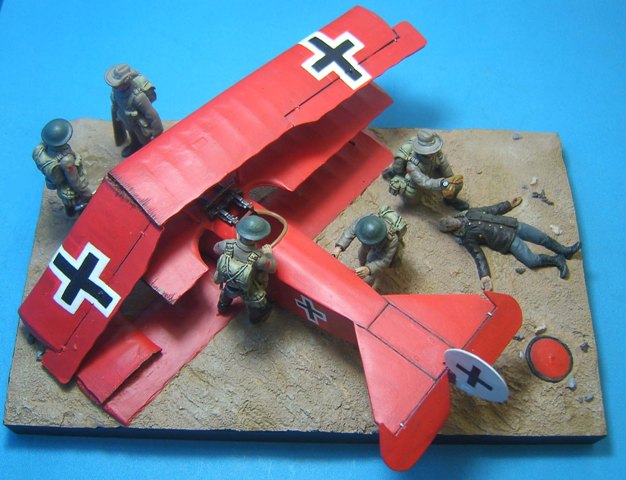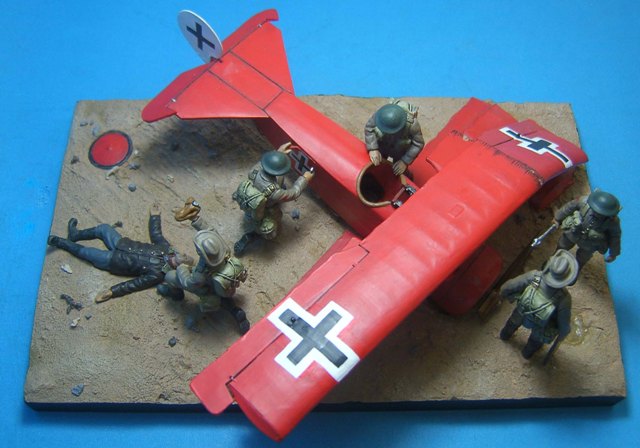You are using an out of date browser. It may not display this or other websites correctly.
You should upgrade or use an alternative browser.
You should upgrade or use an alternative browser.
1/30 WW1 aircraft (1 Viewer)
- Thread starter Mitch
- Start date
A dio set featuring a shot down Red Baron in 1/30 scale would be a good start, would need some Aussies for that

This could work well in 1/30 polystone. The Tripe's wings are shorter than a bi-planes wings and thicker (leading edge wise, anyway) which would lend itself to polystone. The Tripe also has very little in the way of wire rigging to complicate things. Just get the details correct because there might be a rivet counter or two out there.
Louis Badolato
Lieutenant General
- Joined
- Apr 25, 2005
- Messages
- 18,442
A dio set featuring a shot down Red Baron in 1/30 scale would be a good start, would need some Aussies for that

Frontline already did a nice diorama set of this subject. Its probably still available if it is a subject of interest to you, Matt.
OzDigger
Colonel
- Joined
- Jan 7, 2006
- Messages
- 8,833
Frontline already did a nice diorama set of this subject. Its probably still available if it is a subject of interest to you, Matt.
Yes I know thanks Louis, it looked like 1/32 or smaller and I'm 1/30 only these days
I have never seen the Frontline set in person but I believe there were some scale accuracy issues, ie. the figures were larger scale than the Tripe. Anyone know for sure? -- AlYes I know thanks Louis, it looked like 1/32 or smaller and I'm 1/30 only these days
Many years ago there used to be a problem with larger, thin resin wings on model aircraft. Warpage occurred. Twisting was also a problem. Struts might solve the twisting but that wouldn't help the thin winged monoplanes. I don't know if these problems were ever solved or not. I haven't been involved with that stuff in ages. -- AlWe are all surmising that the wings of WW1 planes have to be in polystone they could as easy be a form of resin which, would keep costs down to what they are now.
Mitch
Mascleo
Specialist
- Joined
- Nov 14, 2006
- Messages
- 302
Good idea! I throw my support behind you. I think somebody will make one if he thinks it will sell. WWI releases have grown this year (Australian Light Horse, Turkish soldiers, French, some home front pieces,..) but still minor compared to the WWII releases. A WWI plane will bring more excitement into the series and may get the WWII plane collectors interested in WWI.
And yes, a Fokker and a camel!
And yes, a Fokker and a camel!
As the new aircraft series picks up does anyone else think we should be looking to WW1 for inspiration? I would like to see a sopworth camel or Fokkers with the famous Red Baron redone. Do we think this will happen or, will we stay fixed on WWII?
Mitch
Obee
Major
- Joined
- Aug 27, 2009
- Messages
- 6,183
A dio set featuring a shot down Red Baron in 1/30 scale would be a good start, would need some Aussies for that

For those of you who haven't seen the Frontline Red baron, here are images from thier site:


I don't really like the base they use, as I'd prefer to pose the figures as I like, and use a bigger base, but its a start in the right direction, epecially the WW1 Diggers
John
chiefs70
Specialist
- Joined
- Jul 9, 2006
- Messages
- 311
For those of you who haven't seen the Frontline Red baron, here are images from thier site:
John
Thanks for the post, John. Based on these photos alone I would definitely say there is a scale issue. I don't think the soldier standing next to the cockpit could fit in it if you greased him up with butter.
Eric
OzDigger
Colonel
- Joined
- Jan 7, 2006
- Messages
- 8,833
I have never seen the Frontline set in person but I believe there were some scale accuracy issues, ie. the figures were larger scale than the Tripe. Anyone know for sure? -- Al
Yes, as Obee demonstrated with the photo there were some perceived scale issues between the figures and the aircraft which is why I did not buy it when released.
Mitch
Major General
- Joined
- May 1, 2010
- Messages
- 13,519
With the prevalence of releases and that we have an active WW1 series its got to be a cert along with german tanks to oppose the brit ones released and some more artillery. Only time will tell as its not about our want lists its what the guy in charge wants
Mitch
Mitch
Jagdpanther
2nd Lieutenant
- Joined
- Jun 17, 2008
- Messages
- 3,154
WW1 planes would be nice but I doubt Andy will do it.
I'd love to see 1/30 polystone WW1 aircraft but I don't know that the inherent problems in WW1 planes can be overcome at a decent price point. Construction problems would include weight (multiple wings); how to support the wings (metal struts?); the bracing wires are extremely complicated on most WW1 planes and finding a practical solution to the wires is going to be tough. It will be a challenge to produce affordable WW1 aircraft. -- Al
Louis Badolato
Lieutenant General
- Joined
- Apr 25, 2005
- Messages
- 18,442
I'd love to see 1/30 polystone WW1 aircraft but I don't know that the inherent problems in WW1 planes can be overcome at a decent price point. Construction problems would include weight (multiple wings); how to support the wings (metal struts?); the bracing wires are extremely complicated on most WW1 planes and finding a practical solution to the wires is going to be tough. It will be a challenge to produce affordable WW1 aircraft. -- Al
On the wood biplanes aircraft K&C has produced, including the recent Fairey Swordfish and Gloster Gladiator, wood struts were used, and string was used to replicate the bracing wires. On Heco Tinplate Models, metal struts are used and metal wires are used to replicate the bracing wires. Either of these solutions would work fine with a polystone biplane. I would be more concerned about the weight and fragility of the wings then the struts and bracing wires.
Mitch
Major General
- Joined
- May 1, 2010
- Messages
- 13,519
Lets remember that the wings will be moulded thinly and would not really weigh a great deal. It may be that single wing aircraft are done but for tri winged aircraft etc another medium can be used. I think all the problems can be overturned after talking to a modeller (who hand builds) WW1 aircraft from a number of mediums and has not had any of the difficulties expressed on here.
Mitch
Mitch
Overall, I think that metal struts would have to be used on polystone wings. I wasn't so much worried about the bracing wire material as I was about the expense to apply them. The Wooden KC Biplanes and the Heco models are top grade and a bit out of the affordable ($200 ?) range we are discussing and that the cost of the wiring would have been absorbed within their higher price. The wing weight is a concern as the much thinner biplane wings are going to be delicate. I do not know if combining wooden wings with polystone fuselages is practical construction wise or cost wise. Problems to be solved. -- AlOn the wood biplanes aircraft K&C has produced, including the recent Fairey Swordfish and Gloster Gladiator, wood struts were used, and string was used to replicate the bracing wires. On Heco Tinplate Models, metal struts are used and metal wires are used to replicate the bracing wires. Either of these solutions would work fine with a polystone biplane. I would be more concerned about the weight and fragility of the wings then the struts and bracing wires.
Users who are viewing this thread
Total: 2 (members: 0, guests: 2)

